Best Paper for Watercolor (Expert’s Ultimate Guide!)

Many artists swear that paper is the most essential part of your watercolor supplies!
And I would tend to agree…
Paper is the source of light and the foundation for your paint.
But paper’s quality and handling properties vary enormously depending on the type and brand.
This makes choosing paper somewhat confusing. Especially for beginners!
So… in this comprehensive guide, I will tell you all you need to know about watercolor paper and how to make an informed choice about what to use.
What is watercolor paper?
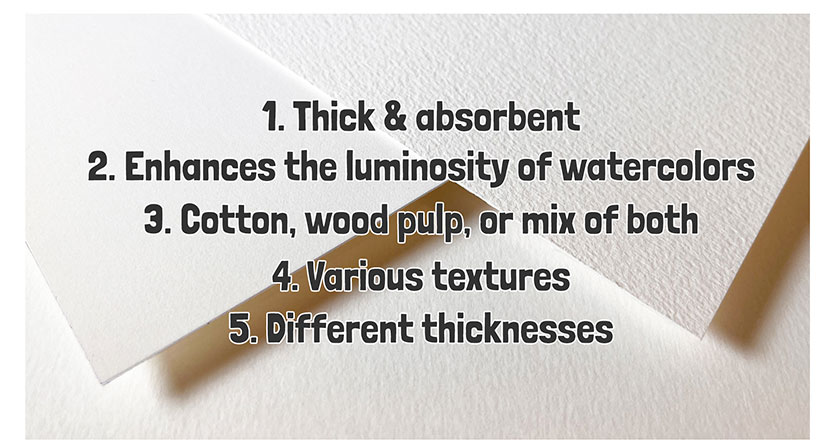
Watercolor paper is a relatively thick and absorbent paper specially designed for wet mediums like watercolors. It enhances the luminosity of watercolor pigments to their fullest. It can be made from cotton fibers, wood pulp, or both. It’s available in different textures and various thicknesses, although the most commonly used type is cold press 300 gsm / 140 lb.
That’s a fairly broad answer.
As you can probably guess, there are many variations within the characteristics described above… The composition, thickness, and surface finish ALL affect how the paper handles with watercolors.
Also, the materials used to make watercolor paper will determine its strength, longevity, and price.

We’ll get into all these details below…
Faced with the abundance of different types of paper on the market, some beginners ask if they really need a special kind of paper to paint with watercolor.
Just so you have no doubts, let me explain…
Do you really need watercolor paper?
Yes, you need to use a special kind of paper to paint correctly with watercolors. Because this painting medium is so wet compared to others, you need a surface that can withstand a lot of moisture!
The clue is in the name – they don’t call it “watercolor paper” for nothing 🙂
What is the difference between watercolor paper and normal paper?
Watercolor paper is thicker and generally more robust than ordinary paper stock. It also has a special finish known as “paper sizing” that alters the absorbency of the paper. This treatment allows the paint to be absorbed into the paper fibers in a balanced way, allowing the artist time to play with the paint before it dries.
Note: sizing isn’t always only a surface coating. A lot of papers are also internally sized.
So what is the best watercolor paper?
For watercolor painting, the best quality paper is made of 100% cotton, is acid-free, with a neutral pH value. It will also be “archival,” meaning the paper will preserve its properties over a long period of time, and your painting won’t fade.
Cotton paper:
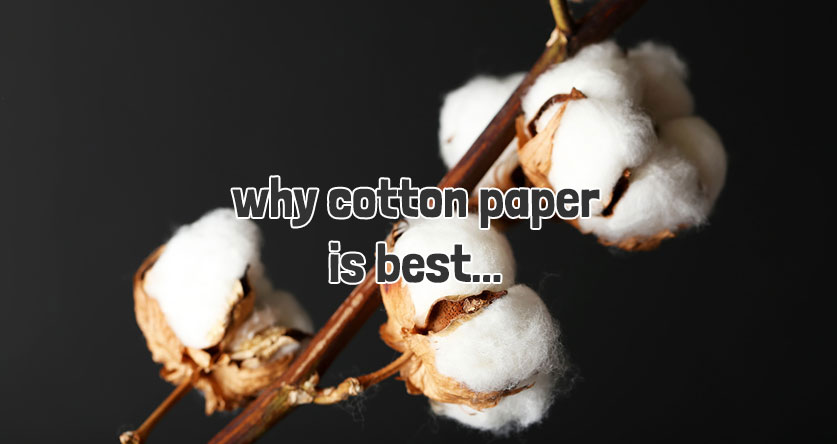
Cotton is stronger and more durable than wood cellulose (the stuff ordinary printer paper is made from). Cotton is a pure source of cellulose. Its fibers are longer, making it tougher and more resistant.
If you’ve ever tried painting on a sheet of standard paper, you’ll see how it disintegrates when you apply wet brush strokes. This doesn’t mean you can’t make watercolor paper from wood pulp! It just won’t stand up to heavy treatment the way cotton does.
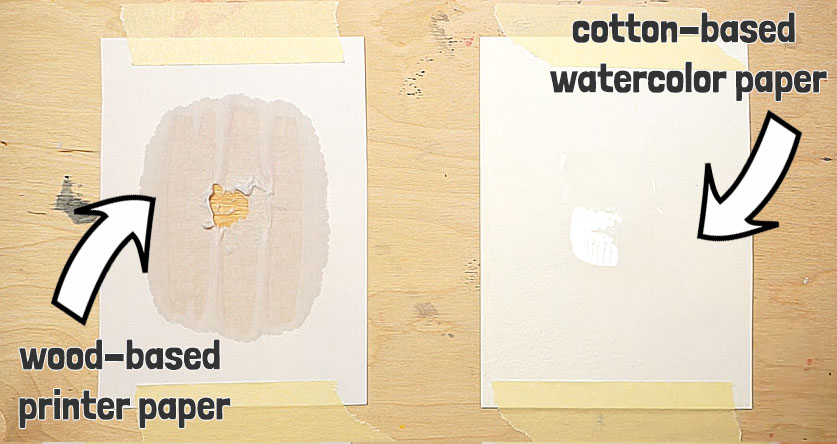
The strength of cotton makes it suitable for use with wet mediums like watercolor. This type of paper is more durable and “dimensionally stable,” meaning it retains its shape better. If you’ve ever painted on watercolor paper, you’ll know it “buckles” and deforms when heavily wetted. Although cotton paper still warps when soaked, it will perform slightly better than wood-based paper.
Cotton also has excellent absorbency properties.
And cotton is also naturally white, which means the paper needs little bleaching or other treatments to alter the color appearance (see “tint & color” below for more about this).
Acid-free / pH neutral:
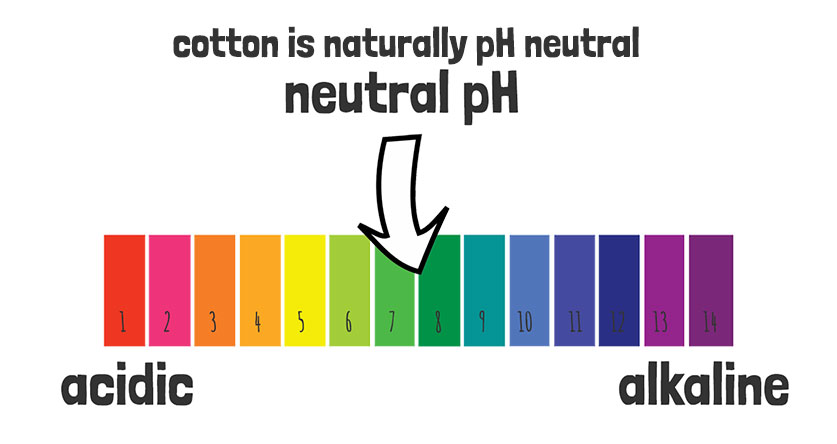
If you remember from your chemistry classes, pH is a measure of the acidity of a substance 🙂
Acid-free and pH-neutral paper indicates it was made using an alkaline pulp and has a neutral pH (pH 7). Wood pulp is naturally acidic. This acidity is removed to avoid yellowing and prevent the sheets from deteriorating over time.
But cotton is naturally archival and pH neutral.
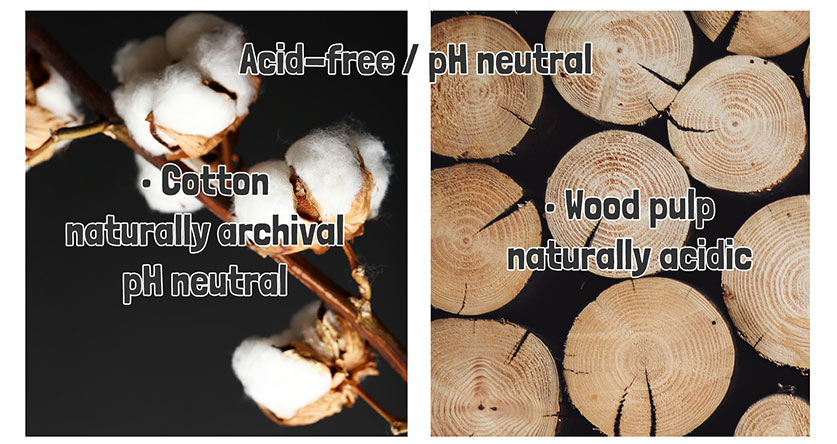
Archival properties:
Acid messes up the longevity of paper. It causes the paper to discolor over time and can even degrade certain paint pigments.
That’s why you should look for acid-free paper.

But cotton is naturally archival and pH neutral!
This property renders the paper archival, meaning it remains stable over time without deteriorating.

After all… You want your masterpieces to last for centuries! Right?
Tint and Color Appearance:
Another aspect of watercolor paper worth mentioning is the tint or general color appearance.
Most papers are not pure white. They need some kind of treatment to make them brighter or more uniform in appearance.
As mentioned above, cotton paper is “naturally” white but not bright white. Some manufacturers add OBAs (optical brightening agents) to make paper pure white.
Extra-white papers are altered with these chemicals.
But OBAs do not last forever!
They fade over time and cause watercolor paints to shift in color. That’s why artist-quality archival papers are not whitened in this way. For longevity, you should favor “natural” off-white paper.
Characteristics of the best kind of watercolor papers:
To sum up, these are the essential properties of artist watercolor sheets. To choose the best paper, remember to look for these features:
- 100% Cotton
- Acid-free
- pH neutral
- Archival
- Traditional color
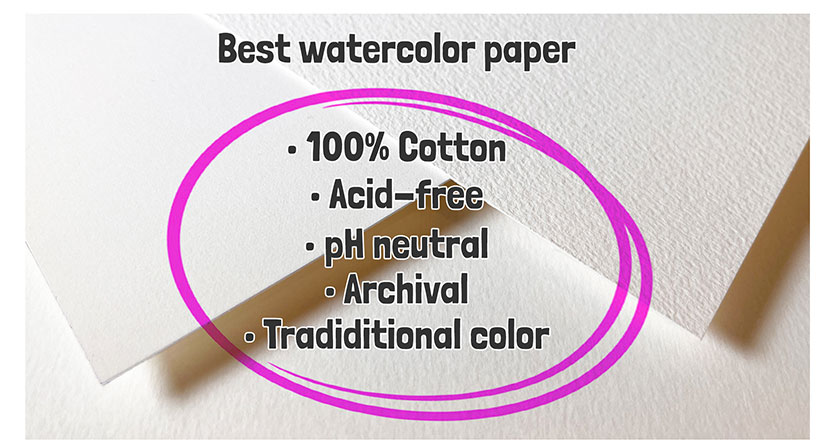
That being said, cotton paper is also the more pricey option. If you’re starting out with watercolors, it’s understandable that you’re reluctant to splash out on high-priced paper…
What is the best watercolor paper for beginners?

The ideal type of watercolor paper for absolute beginners is commonly known as academy-grade paper. These are generally made out of cheaper wood cellulose. This paper has a different quality, durability, and archival properties than artist-grade paper. But it’s more affordable for getting started with watercolors.
(In addition, the most appropriate texture and weight for beginners is cold press paper weighing 300gsm / 140lb. You can read more about textures and weights below.)
It’s true… The “best” watercolor paper can be pretty expensive. The highest quality is generally classed as “artist” grade paper. As a result, this may not be the perfect option for beginners. Spending large amounts of money and living in fear of ruining the paper isn’t fun!
As an alternative, manufacturers make student-grade papers that are more affordable. This makes them better suited to artists who are getting started with this medium and want to experiment.
They are cheaper because they use lower-grade materials such as wood pulp. The internal and surface sizing is also usually poor quality!
Surface handling properties (Sizing)
Before you read further, it’s helpful to talk about sizing. This is an essential factor affecting the paint’s handling properties on the paper surface. Traditionally, the substance used for sizing is gelatin.
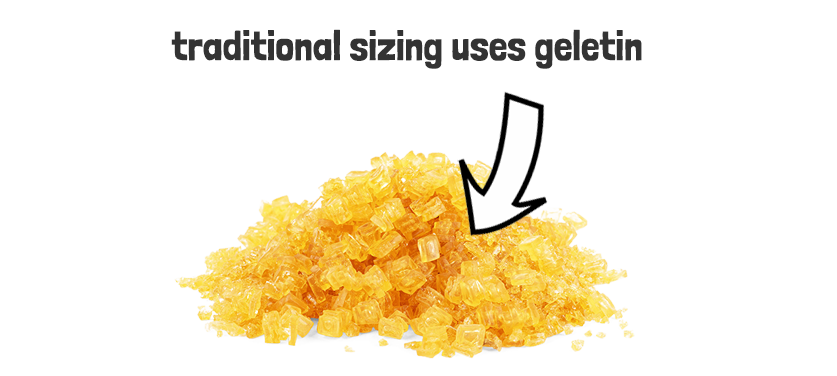
All watercolor paper is sized to alter its absorbency. But sizing involves finding a delicate balance. The paper needs to be sufficiently absorbent to fix the pigments to the surface – but at the same time, not so porous that it sucks the paint deep into the paper fibers, making the colors look dull…
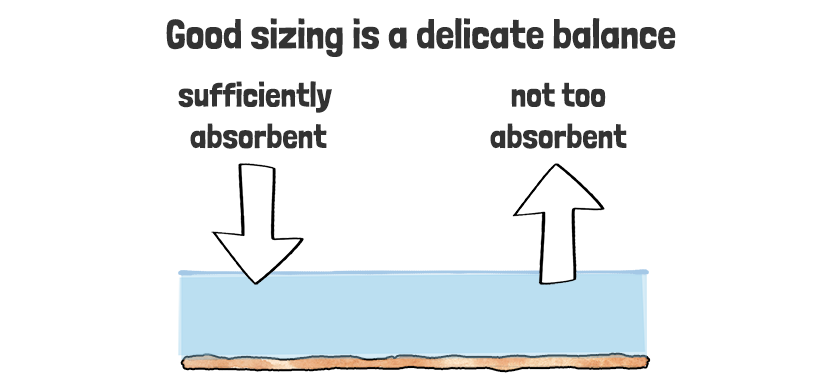
I suggest you read my in-depth article “watercolor paper sizing” for a better understanding.
Types of watercolor paper
The different types of watercolor paper are categorized by three main properties: academy or artist quality, surface texture, and thickness (defined by the weight).
Within these parameters, there’s a lot of choice.
Academy-type papers are great for becoming familiar with watercolor painting. But they are limited. They won’t handle as well as artist-grade paper.
However, there are very good reasons for using both grades. Let’s discuss the differences between these two types of paper:
Academy vs. artist-quality watercolor paper
I consider academy paper essential for beginning with watercolors. It allows you the freedom to splash paint around and develop your early skills without worrying about price constraints.
But as you progress, you’ll benefit by transitioning to artist-grade paper to experience watercolors to their fullest.
FREE Worksheet!
If you’d like to KEEP THIS LESSON you can download the complete 24 page worksheet for free below. I also offer a special series of free watercolor lessons for anyone who signs up to my email newsletter. This is entirely optional (you can skip this and just grab the free stuff below).
You’ll also find a link to my Patreon membership where you can get ad-free video tutorials, plus other exclusive bonuses that I only share with members of my Patreon channel. Follow the link to find out more...
Academy watercolor paper
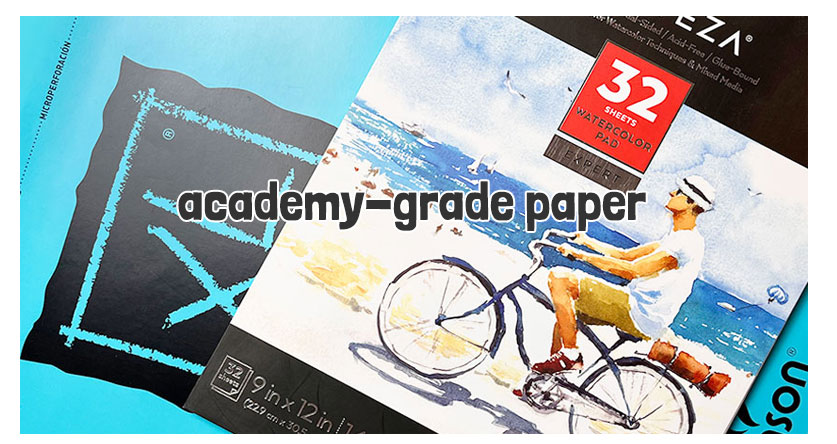
This is the economic version of watercolor paper. It will help you become familiar with the paint before moving on to more expensive sheets.
But getting good results is actually more difficult!
You are more likely to get streaky brush marks or blotches.
The paint reacts differently on these surfaces and is actually more challenging to control.
Which is a bit of a paradox! Because these papers are sold as “academic” grades, but they are, in fact, more difficult to use than pro “artist” grade papers!
Crazy huh?
That is not to say you can’t paint great artwork with this paper. You will just have to accept blemishes and some quirky handling properties. As your skills evolve, you’ll adapt to this type of paper very well and learn to adjust your painting technique.
This type of paper is made from wood pulp and is less durable. It is likely to have been treated to modify the paper’s acidity and may contain brightening agents to make it whiter.
Some of my favorite academy-grade papers include the following:
- Canson XL series
- Arteza Watercolor Paper (Amazon link)
Artist watercolor paper

You’ll really feel a difference when you shift to artist-grade paper.
This paper type is made from 100% cotton, and the sizing is well-adjusted. This means watercolor paints become easier to control. Notably, the dispersion of paint pigments when working wet-on-wet is smooth and uniform. You can create soft blends and transitions in color. Artist-grade paper gives you time to work before it dries. And this type of paper also handles perfectly for glazing (layering paints).
Note: for example, some poorly sized academy papers don’t fix the paint to the surface very well. As a result, when you try to glaze, the pigments lift off the surface when you re-wet the paper. This makes glazing difficult.
My favorite artist papers include:
| Property | Academy Grade Watercolor Paper | Artist Grade Watercolor Paper |
| Materials Used | Lower quality fibers, wood pulp | High-quality cotton or linen fibers |
| Archival Properties | Less archival, lower longevity | Archival, higher longevity |
| Acidity/pH | Buffered to remove acidity, but less pH stability | Naturally acid-free, pH-neutral & alkaline |
| Sizing | Lower quality sizing | Balanced internal & surface sizing |
| Absorption | Moderate to high absorption | High absorption |
| Durability | Less durable, more prone to buckling | More durable, less prone to buckling |
| Price Range | Lower cost | Higher cost |
| Best Suited For | Practice, beginners | intermediate to advanced artists, fine art |
Watercolor Paper Textures (Hot press vs. Cold press vs. Rough)

There are three categories of watercolor paper texture, ranging from smooth to coarse: these are hot press, cold press, and rough. Hot press is smooth, cold press has a medium texture, and rough paper has the most pronounced grain.
Each of these textured surfaces has a different interaction with the paint. You will notice that watercolor paint performs in a distinct way on each surface finish.
Here’s an overview of each one:
Hot press
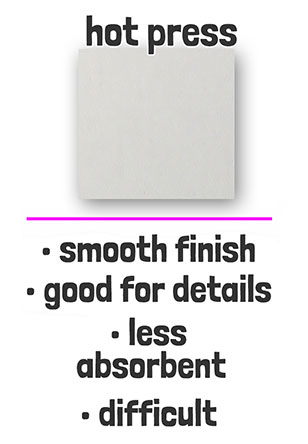
The hot-press paper has the smoothest surface finish. The name comes from the production process of pressing the paper between hot metal rollers to generate a smoother texture.
This surface is perfect for detailed work. There’s no grain to interrupt the flow of your brush strokes. It’s also well adapted to mixed media techniques like pen and wash.
However, the surface is harder and less absorbent than cold press or rough paper. This means it can be tricky to work with as a beginner because the paint absorbs slowly, and watercolor washes can pool on the surface, increasing the risk of unpredictable effects such as back runs or blooms.
Cold press

Cold-pressed paper is also classified as NOT, which stands for “not hot-pressed.” Which I guess is a bit of a mouthful! So it’s more commonly referred to as “cold press.” This name describes the manufacturing process where the paper is pressed between cold metal rollers. The rollers are covered in felt, which imparts a slight texture.
Cold press is more absorbent than hot press paper (but generally less absorbent than rough).
These qualities make it the most “forgiving” type of paper for newcomers. It has a reputation for being easy to use and can tolerate some corrections.
Cold press textures accept some detailed brushwork, but artists can easily make textured brush strokes. This makes the paper well-suited to a wide range of painting styles.
Rough
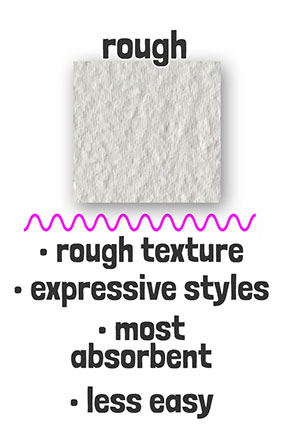
You guessed it! Rough paper is the most heavily textured painting surface for watercolors.
Rough papers are pressed between coarse felt sheets, which emboss the texture onto the damp paper as it dries.
Rough papers tend to be the most absorbent. Brush strokes and irregular watercolor effects such as granulation are more pronounced.
This makes it less easy to work with if you’re new to watercolors but well adapted to expressive painting styles.
| Property | Hot Press Watercolor Paper | Cold Press Watercolor Paper | Rough Watercolor Paper |
| Surface Texture | Smooth | Semi-Textured | Rough |
| Absorption | Less Absorbent | Moderate Absorption | Highly Absorbent |
| Grain Visibility | Minimal or No Grain Visible | Slight Grain Visible | Prominent Grain Visible |
| Application | Ideal for Fine Details | Versatile, All-Purpose | Textured Effects |
| Smooth Washes | Yes | Yes | No |
| Blending | Less Effort Required | Smooth Blending | More Challenging to Blend |
| Best Suited For | Detailed Illustrations | Landscape and Portraits | Expressive Artwork |
Note: paper textures also vary from one manufacturer to another. Because of this, artists usually have their own personal preferences. For example, I like the naturally irregular surface of Arches.
Which is better: cold press or hot press watercolor paper?
Cold press and hot pressed papers are each appropriate to different painting styles and skill levels. As a beginner, the more absorbent and moderately textured surface of cold-press watercolor paper provides an easier surface than smooth hot-press sheets.
I often get asked which type is better, but that’s not the real question…
If you enjoy irregular watery effects or want to paint a lot of detail, try hot-press paper. If you prefer an easy-going surface and expressive dry brush techniques, cold-press is better.
For a more detailed comparison of these two options, I recommend reading my article on cold-press vs hot-press paper.
What paper texture is best for watercolor?
Cold press moderately textured paper is the first choice of most watercolorists. It is the most flexible surface finish because it adapts to so many different ways of painting.
Paper Weight & Thickness
Different thicknesses of watercolor paper are expressed by weight. The heavier the paper, the thicker it is. The most popular and versatile paper weight is 140 lb / 300 gsm.
All manufacturers express weight in two measures:
- lb (pounds per ream)
- gsm (grams per square meter).

The first measure is an older traditional system of measuring paper thickness. The lb (pounds) measurement corresponds to 1 ream of full imperial sheets. But this is also less accurate. The more modern and reliable form of measurement is gsm which is the weight in grams of 1 sheet of paper measuring 1 square meter.

The reason paper thickness is important is because of the paper’s tendency to warp when wet.

The thicker the paper, the less it warps (but it also gets more expensive!)

The best compromise in terms of thickness is 140 lb (which is approximately the same as 300 gsm). This warps less than 90 lb (185 gsm) paper but will still buckle more than very thick 300 lb (640 gsm) paper.
You can begin to see why this is the most popular type of watercolor paper!
I suggest you read this article for a more detailed explanation of paper weights.
Paper Sizes and Formats
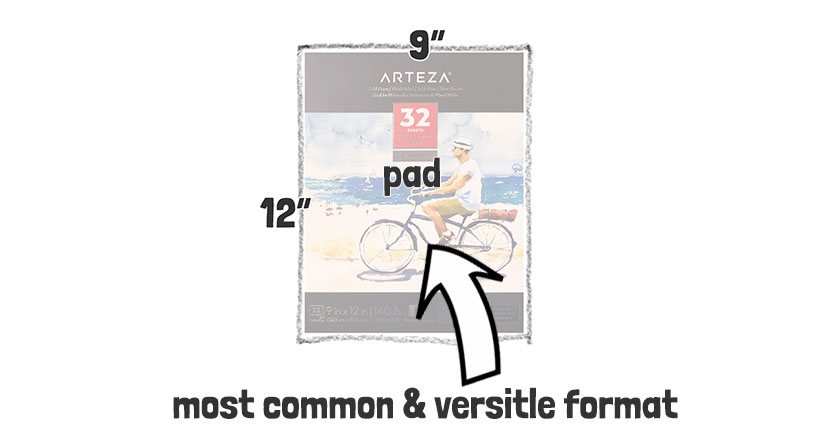
Watercolor paper is available in a confusing array of formats and dimensions. However, the most common and versatile form is 9 by 12 inch watercolor pads.
Pads, blocks, and sheets
Watercolor sheets are usually sold in traditional large-sized formats, the biggest being the imperial full sheet (22 by 30 inches). Not all artists, particularly beginners, need paper this large.
Watercolor pads, on the other hand, are extremely handy. The sheets of paper are glued along one edge, making them easy to remove. They’re sometimes also available as spiral-bound pads. Pads offer a wide variety of smaller, ready-to-use dimensions (compared to sheets, for example).
Blocks are also available in a wide range of dimensions. Blocks are glued on all 4 sides. This holds them slightly flatter when working with wet watercolor washes (but doesn’t completely prevent buckling).
However, blocks prevent you from tracing! You have to freehand your pencil outlines onto the paper, which is time-consuming and potentially harms the paper as you erase sketch lines.
That’s why my favorite format is pads.
Further reading: see my article on watercolor paper sizes for a more in-depth comparison.
Personal Paper Preference
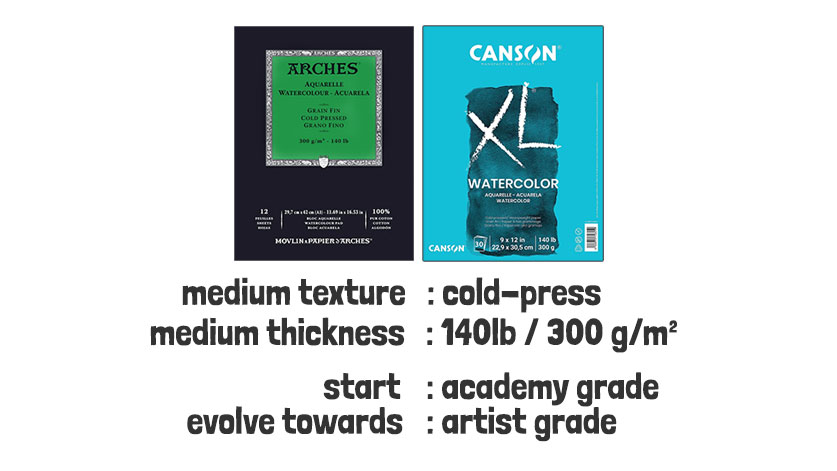
Taking into account all the various paper parameters, for me, the best watercolor paper is as follows:
- Artist grade 100% cotton cold press 140 lb 300 gsm arches 9×12 inch paper pads.
- Academy grade cold press 140 lb 300 gsm 9×12 inch Canson Xl pads.
I consider these the best all-round surface texture, thickness, size, and format for everyday watercolor painting. I also keep larger dimensions of the same paper to hand for painting bigger subjects – usually about 10 x 14 inches.
FAQ
Which side of watercolor paper do you use?
The manufacturing process creates a slightly different surface finish to watercolor paper. To find out whether this makes a difference to the handling qualities of watercolor paints, I examined this question in this article.
How do you stretch watercolor paper?
You’ll notice that watercolor paper bends and distorts when wet. The only way to have a completely flat surface while working is to stretch the paper. Read my guide to stretching watercolor paper here…
Do you have to wet watercolor paper before painting?
When to wet paper or not can be a confusing question for beginners. I will tell you everything you need to know in this article.



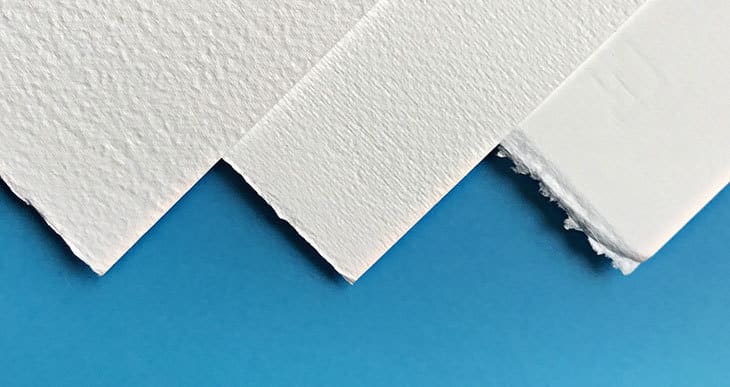


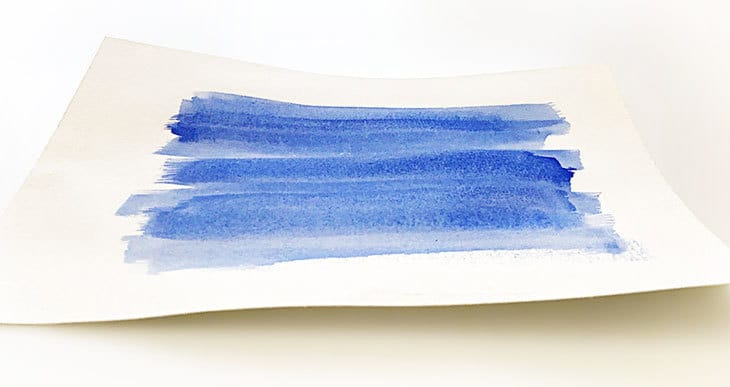

You mention tracing a drawing. How does one trace through so heavy an opaque material as watercolor paper?
Hi Michael,
Works fine on 300 gsm / 140lb watercolor paper using a lightbox.
You can read more about tracing techniques in this article.
Anthony, this is the clearest and most detailed introduction I have found, thank-you. I have been floundering trying to understand the differences – now to move onto brushes – where to start?
Happy to help Tracey!
Guess I’ll have to do the same for brushes some time 🙂
Hi Anthony, Thanks so much for all this information on paper, paints, terms etc. I’m a total newbie to watercolor and this has been so very helpful! Your time and generous sharing of your knowledge is greatly appreciated!
Have fun with your watercolors Diane 🙂
Thanks Anthony your article is really helpful. Presenting it in a table makes it so easy to understand
Glad you found it useful Darlene 🙂
nice article, good info but Arches is the very best!!!! hands down! i’ve tried so many papers, paint and brushes!!!!! it takes trial & error to figure out what works best for each person
I agree Pamela 🙂
This is a terrific explanation of watercolor papers.
Many thanks!
Glad to help !
thanks Anthony, this is very helpful.
You’re welcome Debbie
This is an excellent, thorough, well-illustrated discussion on paper selection. It is a lot of information, but all of it is important to understand why your watercolors may not be doing what you want them to do.